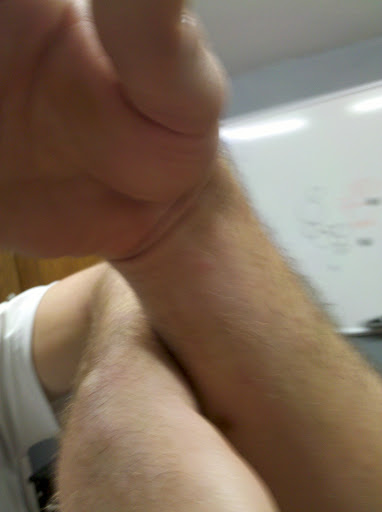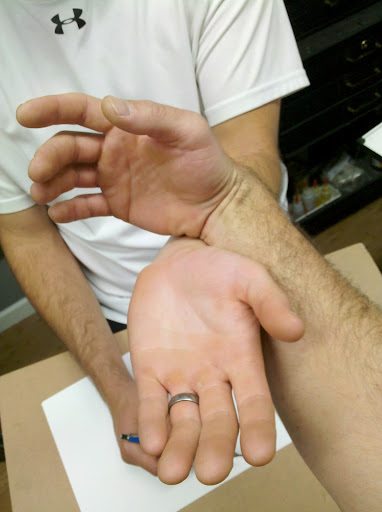mvbrown21
Yellow Belt
Hey guys,
I finally got my brother to illustrate this concept for me so I wanted to share it with you. A small detail but can make a world of difference if applied properly.
We practice our Chi Sao and Dan Chi Sao with what is called the Knife Edge to stick with. It allows you to optimize your stick and at the same time allow you to "feel" the opponents intentions even quicker due to a solid bone to bone contact.
Essentially the "riding arm" makes contact to the opponent by the outside bone of your forearm. I've seen a lot of other systems will stick with the flesh underside of their wrist or the bottom part of their palm. Not saying those methods don't work but I wouldn't say they're optimized either.
Practicing this way will allow you put all of your forward energy(towards the center) behind your elbow. Try this little example out to feel the difference. Hold your left arm out to your center. Now "ride" it with your right and apply the same forward pressure you apply in sticky hands. Try out the fleshy underside first. Then the bottom part of your palm. Now try out this method and imagine you don't have any hands and just use that outside bone, pretty much you're in a straight punch configuration without making a fist. Now tell me which one feels the best.
The way it works is like a knife edge sliding along a board. At the right angle it will eventually "stick" and not be able to slide along the board anymore. The important part here is the bone to bone contact. That outside bone is your knife edge and your forearm is the angle with your elbow being the handle. Imagine one of those razor blade scrapper knifes to understand what I mean.

Now when the opponent rolls from tan to bong keep that forward pressure even and his arm will actually work like a conveyor belt lifting your stick up about an inch or so from it's original location. You're stick will never slip using this method. The reason this works is because since you have bone to bone contact, as he rolls from his inside bone to his outside bone he's actually lifting your riding arm up for you helping you stick to him! Watch, move from tan to bong right now to see what I mean or even better try it out with someone.

And when he rolls back down you'll end up in the original configuration. You're opponent will truly do all the work for you with you're only obligation being to equalize.

_
You can also see it in the "roll" in this video with my Sifu:
This is a really important concept though. Almost every block/redirection comes out of bone to bone contact if your really think about it. The fleshy part of our arms are in the minority for usefulness. The closer we can actually touch the structure, i.e. bones, the easier it will be to control. This method will teach you to "cut in" into the opponents structure whenever you stick.
I finally got my brother to illustrate this concept for me so I wanted to share it with you. A small detail but can make a world of difference if applied properly.
We practice our Chi Sao and Dan Chi Sao with what is called the Knife Edge to stick with. It allows you to optimize your stick and at the same time allow you to "feel" the opponents intentions even quicker due to a solid bone to bone contact.
Essentially the "riding arm" makes contact to the opponent by the outside bone of your forearm. I've seen a lot of other systems will stick with the flesh underside of their wrist or the bottom part of their palm. Not saying those methods don't work but I wouldn't say they're optimized either.
Practicing this way will allow you put all of your forward energy(towards the center) behind your elbow. Try this little example out to feel the difference. Hold your left arm out to your center. Now "ride" it with your right and apply the same forward pressure you apply in sticky hands. Try out the fleshy underside first. Then the bottom part of your palm. Now try out this method and imagine you don't have any hands and just use that outside bone, pretty much you're in a straight punch configuration without making a fist. Now tell me which one feels the best.
The way it works is like a knife edge sliding along a board. At the right angle it will eventually "stick" and not be able to slide along the board anymore. The important part here is the bone to bone contact. That outside bone is your knife edge and your forearm is the angle with your elbow being the handle. Imagine one of those razor blade scrapper knifes to understand what I mean.

Now when the opponent rolls from tan to bong keep that forward pressure even and his arm will actually work like a conveyor belt lifting your stick up about an inch or so from it's original location. You're stick will never slip using this method. The reason this works is because since you have bone to bone contact, as he rolls from his inside bone to his outside bone he's actually lifting your riding arm up for you helping you stick to him! Watch, move from tan to bong right now to see what I mean or even better try it out with someone.

And when he rolls back down you'll end up in the original configuration. You're opponent will truly do all the work for you with you're only obligation being to equalize.

_
You can also see it in the "roll" in this video with my Sifu:
This is a really important concept though. Almost every block/redirection comes out of bone to bone contact if your really think about it. The fleshy part of our arms are in the minority for usefulness. The closer we can actually touch the structure, i.e. bones, the easier it will be to control. This method will teach you to "cut in" into the opponents structure whenever you stick.
Last edited by a moderator:
